
The Potomac River is a major river in the Mid-Atlantic region of the United States that flows from the Potomac Highlands in West Virginia to the Chesapeake Bay in Maryland. It is 405 miles (652 km) long, with a drainage area of 14,700 square miles (38,000 km2), and is the fourth-largest river along the East Coast of the United States and the 21st-largest in the United States. Over 5 million people live within its watershed.
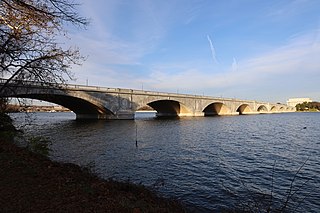
The Arlington Memorial Bridge is a Neoclassical masonry, steel, and stone arch bridge with a central bascule that crosses the Potomac River at Washington, D.C., the capital of the United States. First proposed in 1886, the bridge went unbuilt for decades thanks to political quarrels over whether the bridge should be a memorial, and to whom or what. Traffic problems associated with the dedication of the Tomb of the Unknown Soldier in November 1921 and the desire to build a bridge in time for the bicentennial of the birth of George Washington led to its construction in 1932.
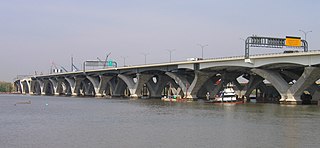
The Woodrow Wilson Memorial Bridge, also known as the Woodrow Wilson Bridge or the Wilson Bridge, is a bascule bridge that spans the Potomac River between Alexandria, Virginia and Oxon Hill, Maryland in Prince George's County, Maryland. The original bridge was one of only a handful of drawbridges in the Interstate Highway System. It contained the only portion of the Interstate System owned and operated by the federal government until construction was completed and it was turned over to the Virginia and Maryland departments of transportation.

Theodore Roosevelt Island is an 88.5-acre (358,000 m2) island and national memorial located in the Potomac River in Washington, D.C. During the Civil War, it was used as a training camp for the United States Colored Troops. The island was given to the federal government by the Theodore Roosevelt Association in memory of the 26th president, Theodore Roosevelt. Until then, the island had been known as My Lord's Island, Barbadoes Island, Mason's Island, Analostan Island, and Anacostine Island.

The Theodore Roosevelt Bridge is a bridge crossing the Potomac River which connects Washington, D.C., with the Commonwealth of Virginia. The bridge crosses over Theodore Roosevelt Island, and carries Interstate 66/U.S. Route 50. The center lane in the bridge is reversible; the middle barrier is moved with a barrier transfer machine. It's operated eastbound during the morning rush hour from 6-11 am. The bridge is named in honor of Theodore Roosevelt, the 26th President of the United States.
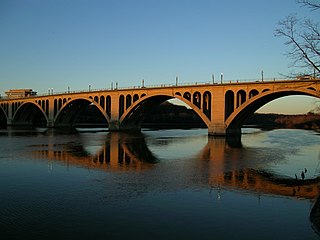
The Francis Scott Key Bridge, more commonly known as the Key Bridge, is a six-lane reinforced concrete arch bridge conveying U.S. Route 29 (US 29) traffic across the Potomac River between the Rosslyn neighborhood of Arlington County, Virginia, and the Georgetown neighborhood of Washington, D.C. Completed in 1923, it is Washington's oldest surviving road bridge across the Potomac River.
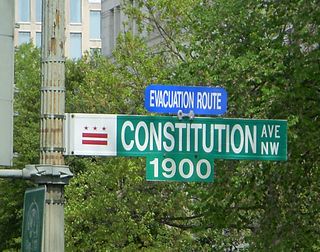
Constitution Avenue is a major east–west street in the northwest and northeast quadrants of the city of Washington, D.C., in the United States. It was originally known as B Street, and its western section was greatly lengthened and widened between 1925 and 1933. It received its current name on February 26, 1931, though it was almost named Jefferson Avenue in honor of Thomas Jefferson.
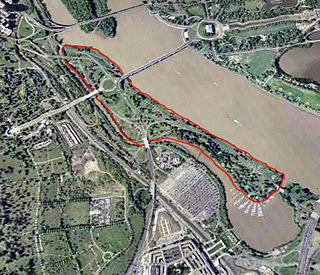
Lady Bird Johnson Park, formerly known as Columbia Island until 1968, is an island located in the Potomac River in Washington, D.C., in the United States. It formed naturally as an extension of Analostan Island in the latter part of the 1800s, and over time erosion and flooding severed it from Analostan, now known as Theodore Roosevelt Island. The U.S. federal government deposited material dredged from the Potomac River on the island between 1911 and 1922, and again from 1925 to 1927. The island was also reshaped by the government at this time "to serve as the western terminus of Arlington Memorial Bridge and a symbolic entrance into the nation’s capital." Located within the park are the Lyndon Baines Johnson Memorial Grove, Navy – Merchant Marine Memorial, and the Columbia Island Marina. The island, park, memorials, and marina are part of the George Washington Memorial Parkway and administered by the National Park Service.

The Three Sisters are three rocky islands in the Potomac River in Washington, D.C., west of the Key Bridge. A notable landmark in colonial times, the islets are less well known as the Three Sisters Islands and Three Sisters Island.

Independence Avenue is a major east-west street in the southwest and southeast quadrants of the city of Washington, D.C., in the United States, running just south of the United States Capitol. Originally named South B Street, Independence Avenue SW was constructed between 1791 and 1823. Independence Avenue SE was constructed in pieces as residential development occurred east of the United States Capitol and east of the Anacostia River. Independence Avenue SW received its current name after Congress renamed the street in legislation approved on April 13, 1934. Independence Avenue SW originally had its western terminus at 14th Street SW, but was extended west to Ohio Drive SW between 1941 and 1942. The government of the District of Columbia renamed the portion of the road in the southeast quadrant of the city in 1950.

East Potomac Park is a park located on a man-made island in the Potomac River in Washington, D.C., United States. The island is between the Washington Channel and the Potomac River, and on it the park lies southeast of the Jefferson Memorial and the 14th Street Bridge. Amenities in East Potomac Park include the East Potomac Park Golf Course, a miniature golf course, a public swimming pool, tennis courts, and several athletic fields. The park is a popular spot for fishing, and cyclists, walkers, inline skaters, and runners heavily use the park's roads and paths. A portion of Ohio Drive SW runs along the perimeter of the park.

The Aqueduct Bridge was a bridge between Georgetown, Washington, D.C., and Rosslyn, Virginia. It was built to transport cargo-carrying boats on the Chesapeake and Ohio Canal in Georgetown across the Potomac River to the Alexandria Canal. The same eight piers supported two different bridges: a wooden canal bridge and an iron truss bridge carrying a roadway and an electric trolley line. The bridge was closed in 1923 after the construction of the nearby Key Bridge. The shuttered Aqueduct Bridge was demolished in 1933 though its arched, stone abutment on the Georgetown (north) end is still present and overseen by the National Park Service as an historic site.
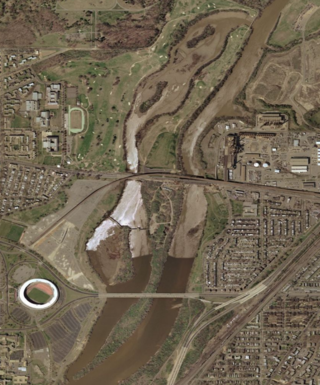
Kingman Island and Heritage Island are islands in Northeast and Southeast Washington, D.C., in the Anacostia River. Both islands are man-made, built from material dredged from the Anacostia River and completed in 1916. Kingman Island is bordered on the east by the Anacostia River, and on the west by 110-acre (45 ha) Kingman Lake. Heritage Island is surrounded by Kingman Lake. Both islands were federally owned property managed by the National Park Service until 1995. They are currently owned by the D.C. government, and managed by Living Classrooms National Capital Region. Kingman Island is bisected by Benning Road and the Ethel Kennedy Bridge, with the southern half of the island bisected again by East Capitol Street and the Whitney Young Memorial Bridge. As of 2010, Langston Golf Course occupied the northern half of Kingman Island, while the southern half of Kingman Island and all of Heritage Island remained largely undeveloped. Kingman Island, Kingman Lake and nearby Kingman Park are named after Brigadier General Dan Christie Kingman, the former head of the United States Army Corps of Engineers.

Kingman Lake is a 110-acre (0.45 km2) artificial lake located in the Anacostia River in Washington, D.C., in the United States. The lake was created in 1920 when the United States Army Corps of Engineers used material dredged from the Anacostia River to create Kingman Island. The Corps of Engineers largely blocked the flow of the Anacostia River to the west of Kingman Island, creating the lake. Kingman Lake is currently managed by the National Park Service.

Greenway is a residential neighborhood in Southeast Washington, D.C., in the United States. The neighborhood is bounded by East Capitol Street to the north, Pennsylvania Avenue SE to the south, Interstate 295 to the west, and Minnesota Avenue to the east.

The Amtrak Railroad Anacostia Bridge is a railway bridge that crosses the Anacostia River in Washington, D.C. It carries Amtrak's Northeast Corridor and MARC's Penn Line passenger rail traffic. The bridge was damaged by the 1933 Chesapeake–Potomac hurricane, causing the famous "Crescent Limited wreck".

The Three Sisters Bridge was a planned bridge over the Potomac River in Washington, D.C., with piers on the Three Sisters islets. Envisioned in the 1950s and formally proposed in the 1960s, it was cancelled amid protests in the 1970s.
The construction of the Virginia approaches to Arlington Memorial Bridge was a 16-year road construction project to connect Arlington Memorial Bridge with roads in Arlington County, Virginia, in the United States. Initial design proposals were made in 1926, but extensive political wrangling and indecision delayed the project and even the new bridge itself, which finally opened in 1932 after a connection to the Arlington National Cemetery was made via Memorial Drive.

The construction of Arlington Memorial Bridge was a seven-year construction project in Washington, D.C., in the United States to construct the Arlington Memorial Bridge across the Potomac River. The bridge was authorized by Congress in February 1925, and was completed in January 1932. As a memorial, its decorative features were extensive and intricate, and resolving the design issues over these details took many years. Tall columns and pylons topped by statuary, Greek Revival temple-like structures, and statue groups were proposed for the ends of the bridge. Carvings and inscriptions were planned for the sides of the bridge, and extensive statuary for the bridge piers.
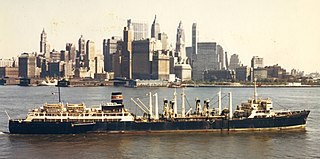
USAVEssayons was a hopper dredge of the United States Army Corps of Engineers. At the time of her construction, she was the largest hopper dredge ever built. She was the flagship of the Army Corps of Engineers dredge fleet. Her primary mission was to maintain the entrance to New York Harbor and other East Coast ports, but she was employed all around the United States and at several international locations. She was launched in 1949 and retired in 1980.




























